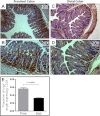CD24 can be used to isolate Lgr5+ putative colonic epithelial stem cells in mice
- PMID: 22723265
- PMCID: PMC3423139
- DOI: 10.1152/ajpgi.00087.2012
CD24 can be used to isolate Lgr5+ putative colonic epithelial stem cells in mice
Abstract
A growing body of evidence has implicated CD24, a cell-surface protein, as a marker of colorectal cancer stem cells and target for antitumor therapy, although its presence in normal colonic epithelium has not been fully characterized. Previously, our group showed that CD24-based cell sorting can be used to isolate a fraction of murine small intestinal epithelial cells enriched in actively cycling stem cells. Similarly, we hypothesized that CD24-based isolation of colonic epithelial cells would generate a fraction enriched in actively cycling colonic epithelial stem cells (CESCs). Immunohistochemistry performed on mouse colonic tissue showed CD24 expression in the bottom half of proximal colon crypts and the crypt base in the distal colon. This pattern of distribution was similar to enhanced green fluorescent protein (EGFP) expression in Lgr5-EGFP mice. Areas expressing CD24 contained actively proliferating cells as determined by ethynyl deoxyuridine (EdU) incorporation, with a distinct difference between the proximal colon, where EdU-labeled cells were most frequent in the midcrypt, and the distal colon, where they were primarily at the crypt base. Flow cytometric analyses of single epithelial cells, identified by epithelial cell adhesion molecule (EpCAM) positivity, from mouse colon revealed an actively cycling CD24(+) fraction that contained the majority of Lgr5-EGFP(+) putative CESCs. Transcript analysis by quantitative RT-PCR confirmed enrichment of active CESC markers [leucine-rich-repeat-containing G protein-coupled receptor 5 (Lgr5), ephrin type B receptor 2 (EphB2), and CD166] in the CD24(+)EpCAM(+) fraction but also showed enrichment of quiescent CESC markers [leucine-rich repeats and immunoglobin domains (Lrig), doublecortin and calmodulin kinase-like 1 (DCAMKL-1), and murine telomerase reverse transcriptase (mTert)]. We conclude that CD24-based sorting in wild-type mice isolates a colonic epithelial fraction highly enriched in actively cycling and quiescent putative CESCs. Furthermore, the presence of CD24 expression in normal colonic epithelium may have important implications for the use of anti-CD24-based colorectal cancer therapies.
Figures







Similar articles
-
Sorting mouse jejunal epithelial cells with CD24 yields a population with characteristics of intestinal stem cells.Am J Physiol Gastrointest Liver Physiol. 2011 Mar;300(3):G409-17. doi: 10.1152/ajpgi.00453.2010. Epub 2010 Dec 23. Am J Physiol Gastrointest Liver Physiol. 2011. PMID: 21183658 Free PMC article.
-
Isolation and characterization of intestinal stem cells based on surface marker combinations and colony-formation assay.Gastroenterology. 2013 Aug;145(2):383-95.e1-21. doi: 10.1053/j.gastro.2013.04.050. Epub 2013 May 2. Gastroenterology. 2013. PMID: 23644405 Free PMC article.
-
Doublecortin and CaM kinase-like-1 and leucine-rich-repeat-containing G-protein-coupled receptor mark quiescent and cycling intestinal stem cells, respectively.Stem Cells. 2009 Oct;27(10):2571-9. doi: 10.1002/stem.193. Stem Cells. 2009. PMID: 19676123 Free PMC article.
-
Development, validation and implementation of an in vitro model for the study of metabolic and immune function in normal and inflamed human colonic epithelium.Dan Med J. 2015 Jan;62(1):B4973. Dan Med J. 2015. PMID: 25557335 Review.
-
Lessons from common markers of tumor-initiating cells in solid cancers.Cell Mol Life Sci. 2011 Dec;68(24):4009-22. doi: 10.1007/s00018-011-0772-9. Epub 2011 Jul 24. Cell Mol Life Sci. 2011. PMID: 21786143 Free PMC article. Review.
Cited by
-
Intracellular DNA replication and differentiation of Trypanosoma cruzi is asynchronous within individual host cells in vivo at all stages of infection.PLoS Negl Trop Dis. 2020 Mar 20;14(3):e0008007. doi: 10.1371/journal.pntd.0008007. eCollection 2020 Mar. PLoS Negl Trop Dis. 2020. PMID: 32196491 Free PMC article.
-
Comparative Study of Extracellular Vesicles from the Urine of Healthy Individuals and Prostate Cancer Patients.PLoS One. 2016 Jun 15;11(6):e0157566. doi: 10.1371/journal.pone.0157566. eCollection 2016. PLoS One. 2016. PMID: 27305142 Free PMC article.
-
Prenatal stress induces changes in PAR2- and M3-dependent regulation of colon primitive cells.Am J Physiol Gastrointest Liver Physiol. 2022 Dec 1;323(6):G609-G626. doi: 10.1152/ajpgi.00061.2022. Epub 2022 Oct 25. Am J Physiol Gastrointest Liver Physiol. 2022. PMID: 36283083 Free PMC article.
-
Transcriptomic but not genomic variability confers phenotype of breast cancer stem cells.Cancer Commun (Lond). 2018 Sep 19;38(1):56. doi: 10.1186/s40880-018-0326-8. Cancer Commun (Lond). 2018. PMID: 30231942 Free PMC article.
-
Proteomic Analysis of Blood Exosomes from Healthy Females and Breast Cancer Patients Reveals an Association between Different Exosomal Bioactivity on Non-tumorigenic Epithelial Cell and Breast Cancer Cell Migration in Vitro.Biomolecules. 2020 Mar 25;10(4):495. doi: 10.3390/biom10040495. Biomolecules. 2020. PMID: 32218180 Free PMC article.
References
-
- Altmann GG. Morphological observations on mucus-secreting nongoblet cells in the deep crypts of the rat ascending colon. Am J Anat 167: 95–117, 1983 - PubMed
-
- Barker N, van Es JH, Kuipers J, Kujala P, van den Born M, Cozijnsen M, Haegebarth A, Korving J, Begthel H, Peters PJ, Clevers H. Identification of stem cells in small intestine and colon by marker gene Lgr5. Nature 449: 1003–1007, 2007 - PubMed
Publication types
MeSH terms
Substances
Grants and funding
LinkOut - more resources
Full Text Sources
Medical
Research Materials
Miscellaneous

